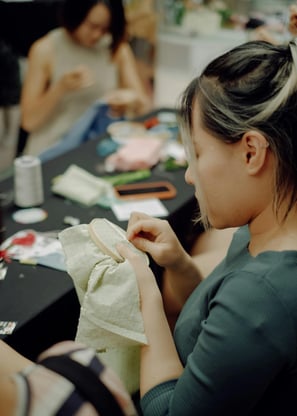Collective Embroidery and Productivity: A Winning Combination
Collective embroidery, where multiple embroiderers collaborate on a single project, can greatly enhance productivity and creativity. By dividing tasks and leveraging individual strengths, projects are completed faster and with superior quality. This collaborative approach fosters a supportive environment, promotes skill-sharing, and sparks innovative solutions. Despite challenges like maintaining consistency and coordinating efforts, effective management and clear communication can ensure success. Embracing collective embroidery can transform your projects, making them more efficient and beautifully crafted.
5/21/20242 min read


Embroidery, an ancient art, is often seen as a solitary and meditative activity.
However, when it becomes a collective endeavor, it can transform into
a highly productive and enriching experience.
This article delves deeply into how collective embroidery can boost productivity,
the benefits and challenges associated with it, and practical tips to maximize results.
What is Collective Embroidery?
Collective embroidery involves multiple embroiderers working together on the same project. This collaboration can take various forms: each person might work on a different section of a large design, or several people might take turns embroidering the same pattern. This collaborative mode of working can be particularly useful for large-scale projects or urgent orders requiring quick turnaround.
Benefits of Collective Embroidery
Efficient Task Distribution:
Reduced Timeframe: By dividing the work, each embroiderer can focus on a specific part of the project, allowing simultaneous progress on multiple sections and accelerating the overall process.
Specialization: Each team member can specialize in a particular technique, which not only enhances the quality of the work but also its speed.
Increased Motivation and Mutual Support:
Team Spirit: Working in a group fosters a sense of community and shared purpose, which can significantly boost motivation and morale.
Support System: Team members can encourage and assist each other, making the work environment more enjoyable and supportive.
Skill Sharing and Learning:
Knowledge Exchange: Members can learn from one another and share tips and techniques, leading to skill improvement for everyone involved.
Innovative Solutions: Collaborative efforts often lead to creative problem-solving and innovative approaches that might not emerge in solitary work.
Enhanced Creativity:
Diverse Perspectives: Different members bring unique perspectives and ideas, leading to more creative and diverse designs.
Collective Brainstorming: Group brainstorming sessions can spark new ideas and concepts that enhance the final product.
Challenges of Collective Embroidery
Coordination:
Synchronization: Ensuring that all members are working in harmony and that their efforts are well-coordinated can be challenging.
Consistent Quality: Maintaining a uniform style and quality across the work of multiple people requires careful planning and oversight.
Communication:
Clarity: Clear and effective communication is essential to avoid misunderstandings and errors.
Conflict Resolution: Differences in opinions or techniques can lead to conflicts, which need to be managed diplomatically.
Logistics:
Material Management: Ensuring that all necessary materials are available and properly distributed among team members is crucial.
Workspace Organization: Providing a well-organized workspace where multiple people can work comfortably and efficiently is important.
Tips for Maximizing Productivity in Collective Embroidery
Define Roles and Responsibilities:
Clearly outline who is responsible for what part of the project to avoid overlap and confusion.
Establish a Timeline:
Set realistic deadlines for each stage of the project to keep everyone on track and ensure timely completion.
Regular Check-ins:
Hold regular meetings to review progress, address any issues, and make necessary adjustments.
Use Technology:
Leverage project management tools and communication platforms to facilitate coordination and information sharing.
Foster a Positive Environment:
Encourage open communication, mutual respect, and a supportive atmosphere to enhance teamwork and productivity.
Conclusion
Collective embroidery, when well-managed, can be significantly more productive than working alone. By leveraging the strengths of each team member, fostering a supportive environment, and maintaining clear communication, a group of embroiderers can create beautiful, high-quality works more efficiently. Whether for large projects or tight deadlines, the collaborative approach to embroidery offers a winning combination of speed, creativity, and mutual support.
www.designet.shop
